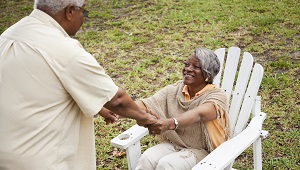Helping older adults improve health by sitting less

Dr. Dori Rosenberg discusses her work on a new Cochrane review looking at ways to help older adults be less sedentary
We live, work, and play in environments that continually prompt us to sit. Unless we have a reason to stand — for example, to cook a meal, walk the dog, or perform a job — chances are good that we are seated.
Studies suggest that all this sitting isn’t good for our health — particularly as we get older and our sitting (and reclining) time tends to increase. Although being more physically active can help counteract this, standing more throughout the day seems to be key. But how do you encourage people to get to their feet more frequently — and to continue doing so over the long term?
Dori Rosenberg, PhD, MPH, is on a mission to find out. As an associate investigator at Kaiser Permanente Washington Health Research Institute (KPWHRI), Dr. Rosenberg has led several studies exploring ways to decrease sitting time. Her leadership in this field was recently recognized when she was invited to co-author the first Cochrane systematic review on interventions to reduce sedentary behavior in older adults. We spoke with Dr. Rosenberg about her participation in this review and what’s next for her research.
What interests you about studying sedentary behavior and ways to reduce it?
Sitting is ubiquitous — everywhere we go and everything we do involves the automatic tendency to sit. When we sit, we aren’t using major muscle groups. Doing this research seems like a wonderful opportunity to help people potentially improve their health with practical changes in standing and light movement, particularly for people with frailty or other significant barriers to being physically active.
Cochrane reviews are regarded internationally as setting the standard for high-quality evidence to inform health care. How did you come to collaborate on this review and what was the process like?
I was invited to participate in a review that was underway by lead author Dr. Sebastien Chastin at the Glasgow Caledonian University. Collaborating on a Cochrane review involves following a very specific process with a lot of complicated software systems. However, it allowed us to all contribute to the review from all over the world. My co-authors included researchers from Belgium, Australia, Spain, the U.K., and Canada.
This is the first time Cochrane has looked at interventions for reducing sedentary behavior among older adults. Why do you think the time was right to do this review?
This is a relatively new field of research and, initially, it was populated only by feasibility studies that often did not include a control group. But there was a growing number of intervention studies with control groups, so it seemed like the right time to do a systematic review.
What were the main findings of the review? Were there any that surprised you?
The studies in the review looked at a range of interventions to reduce sedentary behavior, including counseling, information sessions, goal-setting, and high-tech tools such as activity monitors. When the results from these studies were pooled, the main finding was that sedentary behavior was lower in the intervention group compared to the control group — but only by a small amount overall. I was surprised the effect size was not larger. However, some of the control groups involved promotion of physical activity, which is not ideal since people can become less sedentary if they engage in more physical activity.
What are the implications of this review for future research?
The key takeaway was that we need more rigorous and long-term studies. In particular, we need further studies to see whether we can efficaciously reduce sitting and whether this change in behavior is lasting. We also need studies with control groups that do not provide physical activity interventions.
Studies should also include health outcomes to help us understand whether reducing sitting can promote health improvements as people age.
What’s an example of an intervention you think is promising?
One thing we’ve done in our research is give participants a fitness tracker that goes off every 15 minutes or so to remind people to take breaks from sitting. Because we get so immersed in what we’re doing when we sit, we forget to break it up, so the fitness tracker can be a good reminder.
Are there studies currently underway that you think are especially interesting?
Along with our colleagues, KPWHRI is conducting a study looking at whether we see any changes in cardiovascular health when people reduce their sitting time. It is a randomized controlled trial which will ultimately enroll 284 older adults. The participants work with a health coach and get a standing desk and fitness tracker to help them set and meet goals to reduce their sitting by standing and moving more. There is also a comparison group that focuses on different healthy living topics. Participants are followed for 1 year and we are already halfway through our recruitment goal.
What’s next for your research?
In addition to the trial I mentioned above, we are conducting epidemiologic research to better understand how patterns of sitting, standing, moving, and sleep across the 24-hour day relate to cognitive and functional aging. Because our sleep likely impacts how much we sit and move, we think looking at these whole-day patterns could offer important clues about healthy aging. More to come!
Learn more about Dr. Rosenberg’s research
In the video below, Dr. Rosenberg talks about the Take Active Breaks from Sitting (TABS) pilot study, along with study participant Gerald Alexander. The video was filmed in 2015, before Group Health was acquired by Kaiser Permanente.
Healthy Findings Blog

We decreased people’s daily sedentary time by an hour
Changing behavior isn’t easy, but Dr. Dori Rosenberg helped older people to stand and walk more.
Healthy Aging

Stand up for your health!
Researcher Dori Rosenberg shares the importance of being less sedentary — and tips for sitting less.
Research

Built environment plays little role in weight gain
New research suggests fast food and other aspects of built environments don’t affect weight, contrary to earlier findings.


